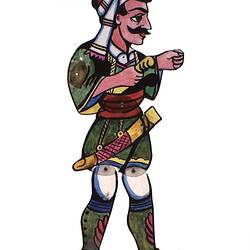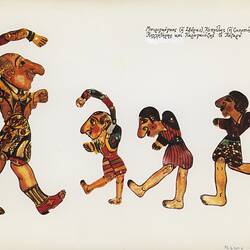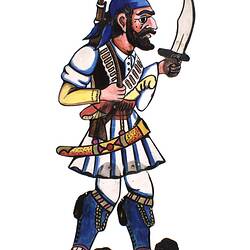Summary
This spear was made in the 1960s by the Greek puppeteer and popular artist Abraam (Antonakos) in his Athens workshop, and used in performances in Greece during the 1960s. This and most of the puppets in the collection were brought to Australia by Abraam Antonakas for his performances at the Astor Theatre in Melbourne in 1977. He then left the collection with Dimitri Katsoulis who used them in all his subsequent performances in Victoria and in South Australia from 1978 to 1991.Dimitri Katsoulis migrated to Australia in 1974 to escape a regime that repressed Greek artists. He had trained in Greece with theatre and film companies as an actor and technician. A master of the traditional Greek shadow puppet theatre, his performances explored contemporary issues such as the isolation of migrant women and children. Unable to obtain funding and support, he returned to Greece in 1991, leaving his entire collection to the people of Victoria. It includes 32 shadow puppets and around 170 props, set backdrops and technical tools and stage equipment. Dimitri has since returned to Melbourne and assists the Museum to continue to document this rich art form within both local and international contexts.
This spear was attached to the hand of Megas Alexandros [Alexander the Great], a character in the centuries-old Greek Shadow Puppet Theatre (Karaghiozis) tradition. It is used only in plays in which Megas Alexandros [Alexander the Great] appears. In the play 'Megas Alexandros [Alexander the Great] and the Cursed Snake', it is the weapon with which Megalexandros [Alexander the Great] confronts the snake. In this play, a huge snake appears in the spiderweb-filled cave and spreads fear and death. The bravest men confronted it but lost their lives. In order to save the public, the Vizier (the Veziris - originally a Persian term for a high-ranking political, and sometimes religious, advisor or minister, often to a Muslim monarch such as a Sultan) offered his daughter and many thousands of pounds to whoever could kill it. Megalexandros [Alexander the Great] appears, confronts the snake and in a very fierce battle he kills it with the help of Karaghiozis. Megalexandros [Alexander the Great] leaves. Karaghiozis tells Hatziavatis [another Greek Shadow Puppet Theatre character], who enters and sees the dead snake, that he killed it himself. They take it and go to Sarai, but the Vizier (the Veziris) is under the impression that they are trying to trick him, so he orders Thervenagas another Greek Shadow Puppet Theatre character] to start beating them both up.
Information supplied by Greek Shadow Puppet Theatre master Dimitri Katsoulis, 2007.
Physical Description
A piece of stiff plastic cut in the shape of a spear. The shaft is painted brown, with a clear section 5 cm long towards one end. The tip is yellow and has been cut as a separate piece and glued into position.
Significance
This collection of puppets, props, stage sets, and technical tools and equipment relating to traditional Greek Shadow Puppet Theatre is unique in Australia and rare in international public collections. The history of Greek Shadow Puppet Theatre, its puppet characters and the methodology of its performance has been recorded in partnership with the puppet master to whom the collection belonged. The collection is highly significant both as documentation of an important cross-cultural, centuries-old art form, and as an example of the transnational migration of cultural activity between Greece and Australia. It is a collection which was created and performed in Greece and Australia from the mid to late twentieth century, by two puppet masters, who transported the tradition between two countries. Abraam Antonakos came to Australia in 1977 to perform the puppet theatre and then deposited the puppets with Dimitri Katsoulis, who had migrated to Australia in 1974. Dimitri's story becomes one of migration experience, cultural maintenance and adaptation, and finally return migration and the discontinuance of this cultural art form in Australia.
More Information
-
Collection Names
-
Collecting Areas
-
Acquisition Information
Purchase
-
Maker
-
User
Mr Abraam Antonakos, Athens, Greece, 1960-1977
Abraam made the puppet in Greece, and used it in performances during the 1960s and 1970s; and then in Victoria in 1977. -
User
Mr Abraam Antonakos, Victoria, Australia, 1977
Abraam made the puppet in Greece, and used it in performances during the 1960s and 1970s; and then in Victoria in 1977. -
User
Mr Dimitri Katsoulis, Australia, 1978-1991
Dimitri was given the puppet by Abraam in 1977 and then used it in his performances in Australia until 1991. -
Classification
-
Category
-
Discipline
-
Type of item
-
Overall Dimensions
2.5 cm (Length), 24 cm (Height)
-
References
[Link 1] Malkin, Michael, R. Traditional and Folk Puppets of the World, A.S. Barnes & Co., Inc., N.J., 1977; Simmen, Rene, The World of Puppets, Elsevier, Phaidon, London, 1975; Hogarth, Ann & Bussell, Jan, Fanfare for Puppets!, David & Charles Publishers Ltd, USA, 1985; Yayannos, A & Ar and Dingli, J. The World of Karaghiozis, 1976
-
Keywords
Cultural Maintenance, Greek Communities, Greek Immigration, Karaghiozis Theatre, Shadow Puppetry, Theatres, Working Life



